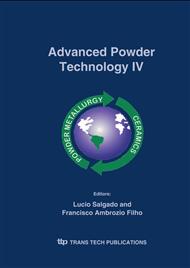p.278
p.285
p.293
p.299
p.305
p.311
p.316
p.319
p.324
Evaluation of the Effect of Heavy Rare Earth Elements on Electrical Resistivity of Zirconia-Yttria Ceramics
Abstract:
The use of yttria concentrates was investigated in this study for synthesis and processing of zirconia based ceramics applied as solid electrolyte materials. Terbium, dysprosium, holmium, erbium and ytterbium are the chemical elements, classified as heavy rare earths, that can be found in those concentrates due to their association with yttrium ores. The ceramic characteristics were compared to zirconia-yttria and zirconia-yttria-heavy rare earth oxide systems, containing 3 and 9 mol% of dopant. Powders were prepared by the coprecipitation route and ceramic processing conditions were established to attain relative densities up to 95%. The characterization of assintered pellets was performed by apparent density measurement by Archimedes method, X-ray diffraction, scanning electron microscopy and electrical resistivity measurement by impedance spectroscopy. It was observed that the presence of heavy rare earths in a concentrate containing 85 wt% of yttria has no significant influence on the total ionic resistivity of zirconia based ceramics.
Info:
Periodical:
Pages:
305-310
Citation:
Online since:
November 2005
Price:
Сopyright:
© 2005 Trans Tech Publications Ltd. All Rights Reserved
Share:
Citation:


